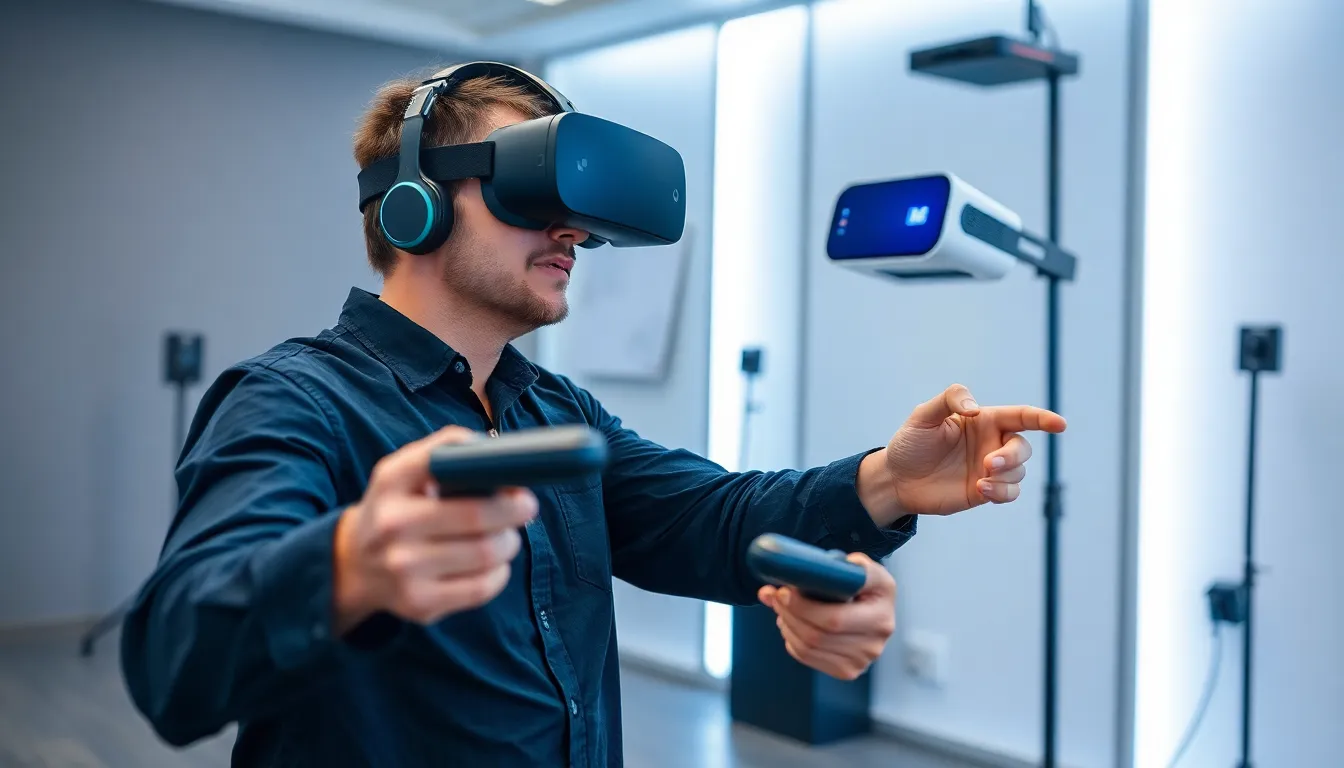Table of Contents
ToggleIn a world where reality sometimes feels a bit too, well, real, virtual reality app development is the magic wand that transforms ordinary experiences into extraordinary adventures. Imagine diving into a digital ocean, battling dragons, or exploring distant galaxies—all from the comfort of your living room. It’s like being a kid again, but with a much cooler headset and fewer naps.
Overview of Virtual Reality App Development
Virtual reality app development creates immersive experiences that captivate users. Developers utilize advanced technology to build applications that transport users to various digital environments. Key components include software development kits, 3D modeling, and user interface design.
The development process often begins with ideation, where creators brainstorm unique concepts. This stage is critical as it shapes the feature set and overall vision of the app. Following ideation, prototyping allows developers to create a preliminary version. A prototype helps visualize functionalities and interactions, enabling better feedback collection.
Design plays a fundamental role in VR apps. Engaging visuals and intuitive navigation enhance user experience. 3D artists and designers work closely to produce high-quality graphics that match the app’s goals.
Testing follows development to ensure functionality and user satisfaction. Beta testing with real users identifies issues and improves app performance. Feedback from testers informs necessary adjustments and refinements.
Integration with platforms also proves essential. Popular VR platforms include Oculus, HTC Vive, and PlayStation VR, each offering unique advantages. Developers must consider target audience and intended use case when selecting a platform.
Launching the app is a significant milestone. Promotion strategies, including social media campaigns and influencer partnerships, help gain visibility. Continuous updates and support keep the app relevant and user-friendly.
Overall, virtual reality app development involves intricate processes and collaboration across various fields. Utilizing the latest technology enhances the potential of creative concepts, leading to captivating experiences that redefine how users interact with digital content.
Key Technologies in Virtual Reality

Virtual reality relies on cutting-edge technologies to create immersive experiences. These technologies fall into two main categories: hardware and software.
VR Hardware
VR hardware encompasses devices like headsets, sensors, and controllers that facilitate user interaction. Popular headsets include Oculus Quest, HTC Vive, and PlayStation VR, each offering unique features and specifications. Sensors track movement, ensuring precise alignment between virtual and real-world environments. Controllers enable users to engage with virtual objects, enhancing the sense of presence. The combination of high-resolution displays and advanced audio systems transports users into fully realized digital worlds. Notably, the advancements in graphics processing units contribute significantly to rendering lifelike environments, ensuring smooth experiences.
VR Software
VR software serves as the backbone of virtual reality experiences. Development tools, such as Unity and Unreal Engine, provide robust platforms for building applications. These tools support 3D modeling, animation, and physics, which are critical for creating engaging experiences. Additionally, application programming interfaces enable seamless integration with various hardware. Game engines streamline the development process by offering pre-built features and assets. Meanwhile, user interface design focuses on creating intuitive experiences that enhance usability. Ultimately, the software development phase emphasizes optimizing performance and enhancing user engagement through captivating narratives and interactive elements.
Development Process
The development process for virtual reality apps involves several critical phases, each contributing to the creation of immersive experiences.
Concept and Design
Innovative concepts form the foundation of virtual reality apps. During this stage, teams brainstorm unique ideas that appeal to users. Creative design follows, encompassing user interfaces, environments, and character models. Graphic designers and 3D artists collaborate to produce high-quality visuals. Accessibility remains a priority, ensuring easy navigation across diverse user skill levels. Consistent iterations during design help refine these elements, enhancing overall engagement.
Prototyping
Prototyping transforms ideas into tangible applications. Developers create sample versions of the app, integrating basic functionalities to test concepts. Early prototypes allow for exploration of user interaction and gameplay mechanics. Feedback collection occurs from team members and potential users, guiding further improvements. Iterative revisions happen based on this input, resulting in a more polished product. Final prototypes set the stage for more extensive testing later.
Testing and Iteration
Testing is crucial for ensuring functionality and user satisfaction. Developers conduct extensive trials to identify bugs and usability issues. User feedback becomes invaluable, guiding necessary adjustments and refinements. Iteration occurs throughout this phase, with multiple rounds of testing helping to perfect the app. Continuous improvements focus on gameplay experience, graphics quality, and immersive aspects. Regular updates keep the app relevant, maintaining user engagement post-launch.
Challenges in Virtual Reality App Development
Virtual reality app development faces significant challenges, including technical limitations and user experience concerns.
Technical Limitations
Technical limitations significantly impact the development of virtual reality applications. Processing power demands remain high, requiring advanced hardware for seamless experiences. Device compatibility varies, leading to challenges in ensuring apps function across multiple platforms. Latency can disrupt user immersion, necessitating precise optimizations. Developers also grapple with graphics rendering capabilities, aiming for high-quality visuals without sacrificing performance. Battery life plays a crucial role, as prolonged use can drain devices rapidly. Overall, these technical hurdles can complicate the development process and affect user satisfaction.
User Experience Concerns
User experience concerns play a vital role in virtual reality app development. High levels of motion sickness can deter users, demanding careful design to minimize discomfort during interactions. Intuitive navigation remains critical, as users must easily understand how to engage with the app. Accessibility considerations arise, ensuring individuals of varying abilities can enjoy the experience. Content variety also influences the overall experience, with diverse offerings maintaining user interest. Regular feedback collection from users aids in refining these aspects, fostering a captivating and immersive environment.
Future Trends in Virtual Reality
Emerging trends in virtual reality (VR) indicate a significant evolution in app development. Advancements in hardware like lightweight headsets improve user comfort and accessibility. Increased processing capabilities support more complex and immersive experiences, pushing developers to create richer environments.
Artificial intelligence integration enhances personalization, allowing apps to adapt to user preferences and behaviors. Gamification elements are becoming prevalent. These features engage users by incorporating reward systems that elevate motivation and retention in applications.
Social interaction within VR is gaining traction, enabling users to connect in shared virtual spaces. This shift fosters collaboration in gaming, education, and training applications, enhancing user engagement and connectivity. Furthermore, remote work solutions capitalize on VR to facilitate more interactive meetings and productive teamwork.
The growth of 5G technology dramatically boosts VR experiences through reduced latency and increased bandwidth. This enhancement supports high-quality streaming and real-time interactions, crucial for applications like multiplayer gaming and virtual events. Developers have started leveraging these network advancements to create seamless experiences.
Sustainability in development practices also emerges as a priority. Eco-friendly approaches reduce the environmental impact of VR production and usage. As awareness of climate change rises, developers focus on creating more sustainable technologies and software, appealing to environmentally conscious users.
Finally, cross-platform compatibility is essential. Users expect seamless transitions between devices, promoting a broader user base and fostering community building. The future of VR app development hinges on addressing these trends, ensuring engaging and accessible experiences for a diverse audience.
Virtual reality app development is set to redefine how users engage with digital content. By leveraging innovative technologies and focusing on user experience, developers can create immersive worlds that captivate and inspire. As advancements continue to emerge in hardware and software, the potential for VR applications expands, offering unique opportunities across various industries.
The emphasis on accessibility and continuous improvement ensures that these experiences remain relevant and enjoyable for all users. With the integration of cutting-edge trends like AI and 5G technology, the future of virtual reality promises to be more engaging and interconnected than ever before. As this field evolves, developers will play a crucial role in shaping the next generation of digital adventures.




